Abstract
Features of asthma include increases in both bronchial responsiveness and variability of airflow rates. We examined the relationship between bronchial responsiveness to histamine and the variation of peak expiratory flow rate (PFR) during the day and in response to salbutamol (200 μg), and the initial FEV1 at the time of the histamine test and FEV1 response to salbutamol. Bronchial responsiveness to histamine was expressed as the provocation concentration causing a fall in FEV1 of 20% (PC20). PC20 ranged between 13·9 and 130 mg/ml in nonasthmatic subjects, between 10·5 and 59·9 mg/ml in five asymptomatic asthmatics, and between 0·03 and 20·8 mg/ml in 27 asthmatics with symptoms controlled by medication. The lower the PC20 (the greater the bronchial responsiveness) the lower the morning PFR (r = 0·79), the greater the increase in PFR after salbutamol (morning r = −0·75, evening r = −0·80), and the greater the difference between the highest and lowest PFR each day (r = −0·81). Measurements of PFR were abnormal, compared with those in nonasthmatic subjects, in all subjects with a PC20 less than 2 mg/ml—that is, moderate or severe increase in nonspecific bronchial responsiveness—and in none with a PC20 greater than 21 mg/ml—that is, normal responsiveness; five of nine asthmatics with controlled symptoms had abnormal PFR measurements when PC20 was between 2 and 21 mg/ml—that is, mild hyperresponsiveness. In contrast, FEV1 at the time of the histamine test was greater than 80% predicted in all subjects with a PC20 greater than 2 mg/ml and was not less than this in 10 of 18 subjects with a PC20 less than 2 mg/ml. When improvement in FEV1 was 20% or more after salbutamol, the PC20 was usually moderately or severely increased (less than 0·4 mg/ml). The results identify a close relationship between nonspecific bronchial responsiveness to histamine and the variability in flow rates which occurs spontaneously and after bronchodilator. In addition, they raise the possibility that increased airflow obstruction in asthma may be a consequence of increased responsiveness.
Full text
PDF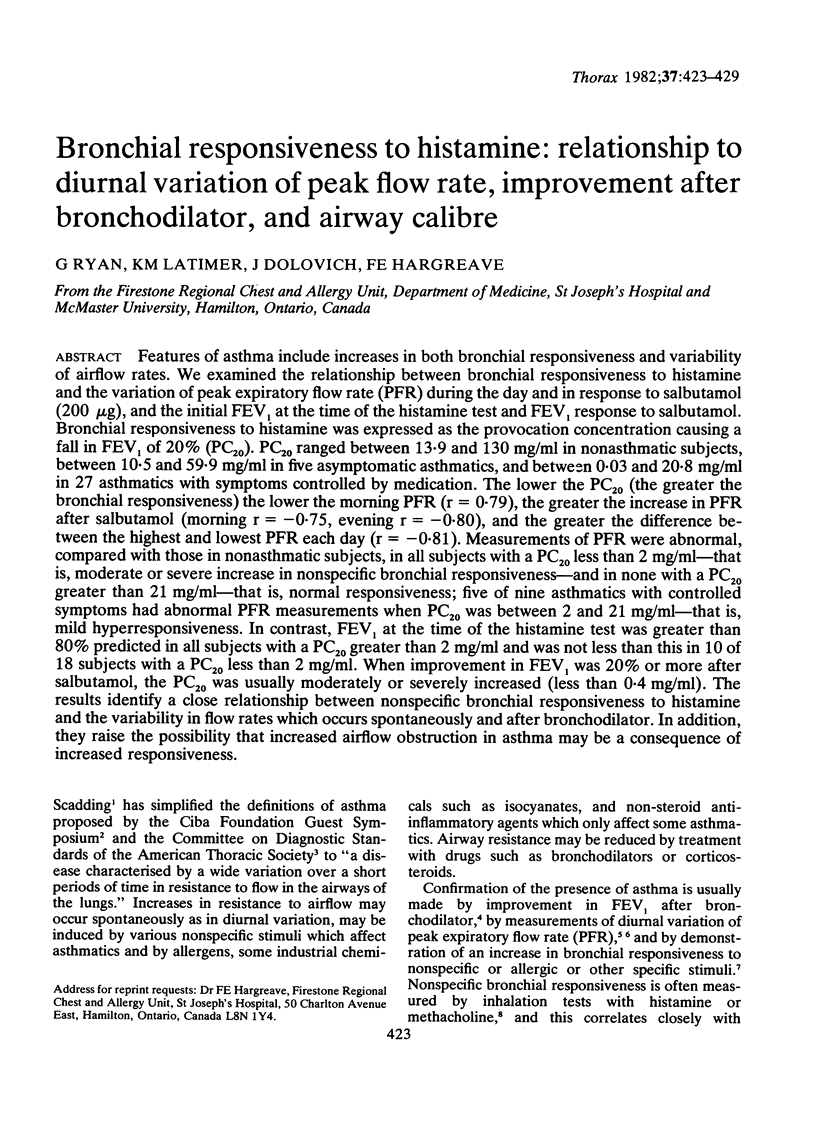
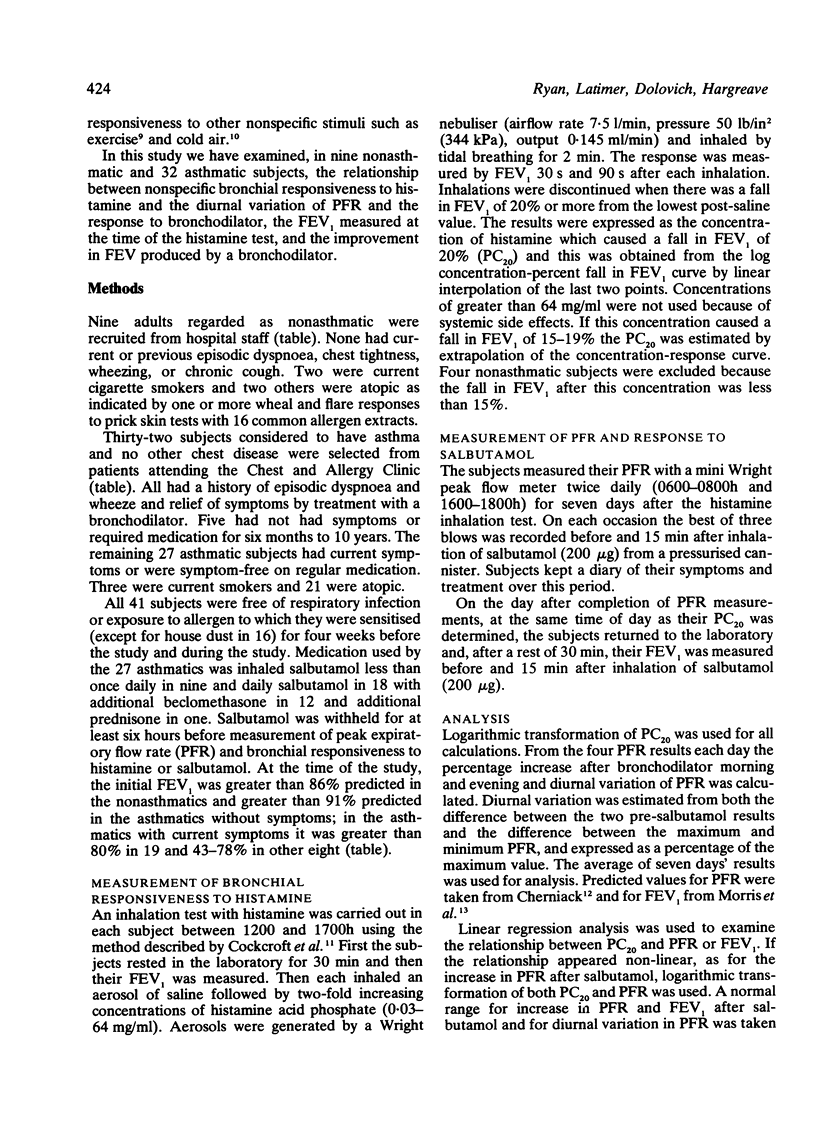
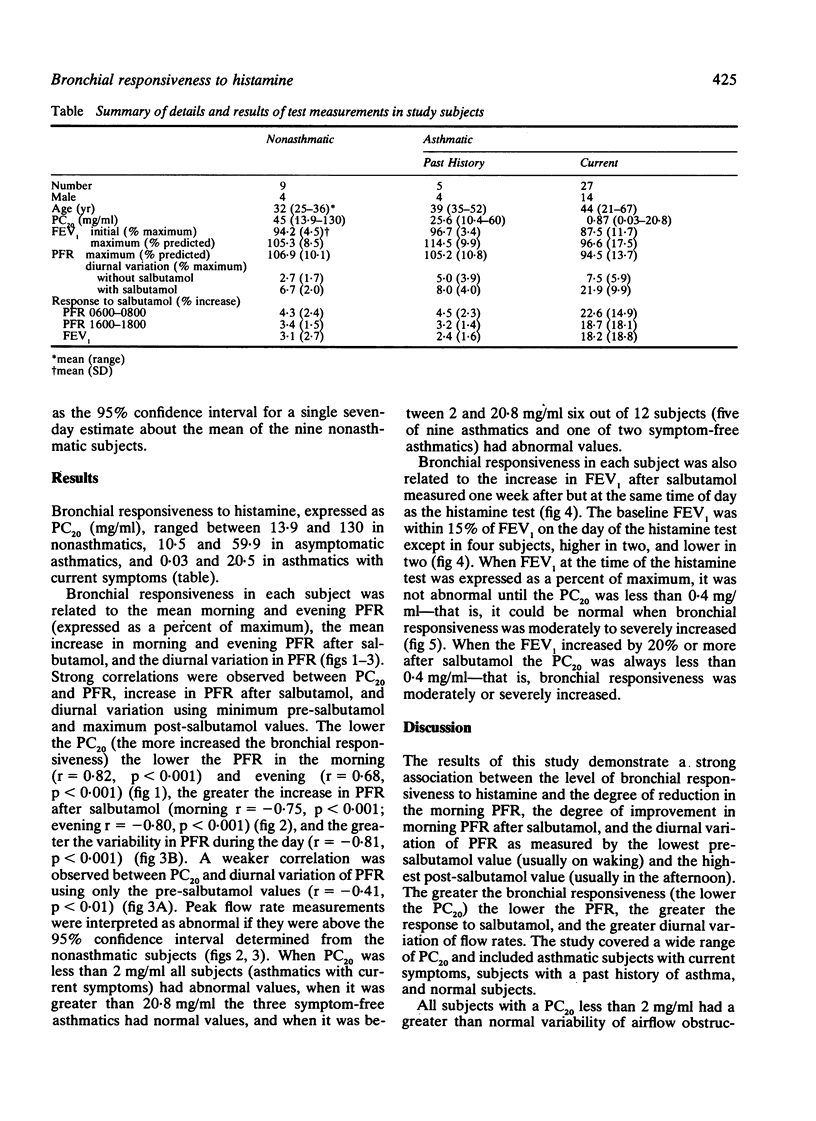
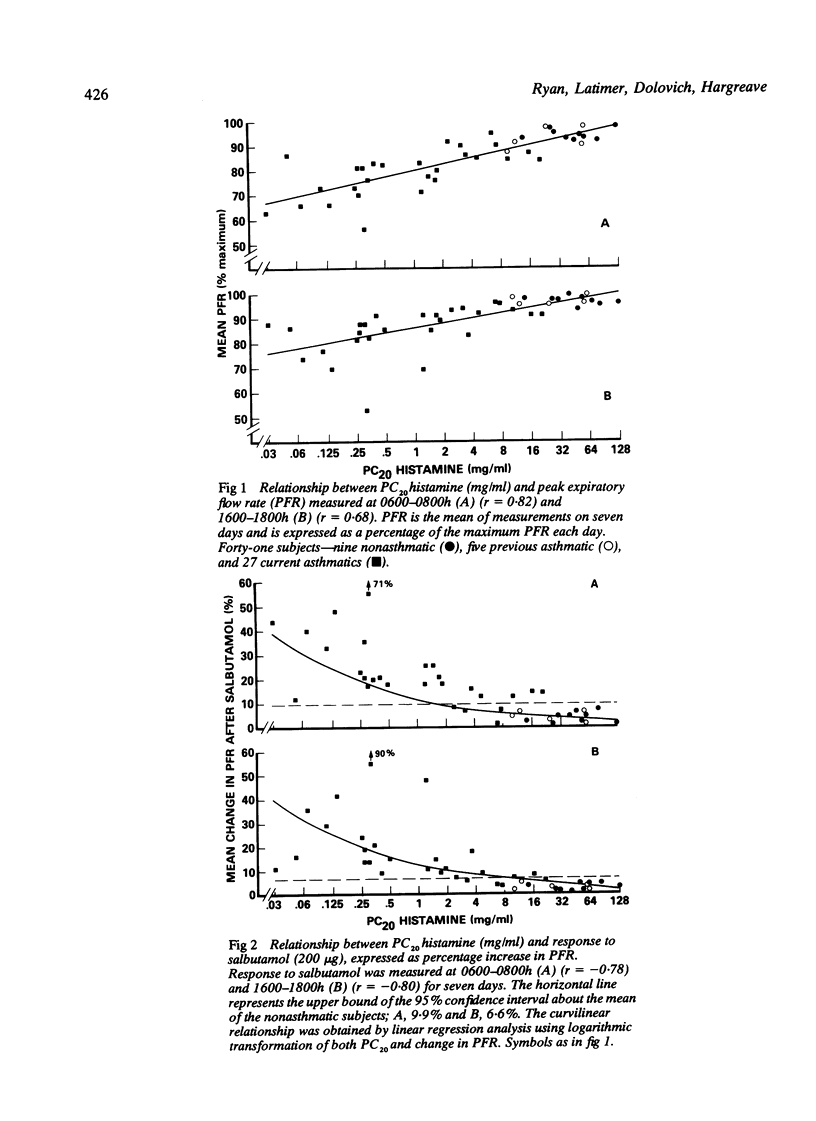
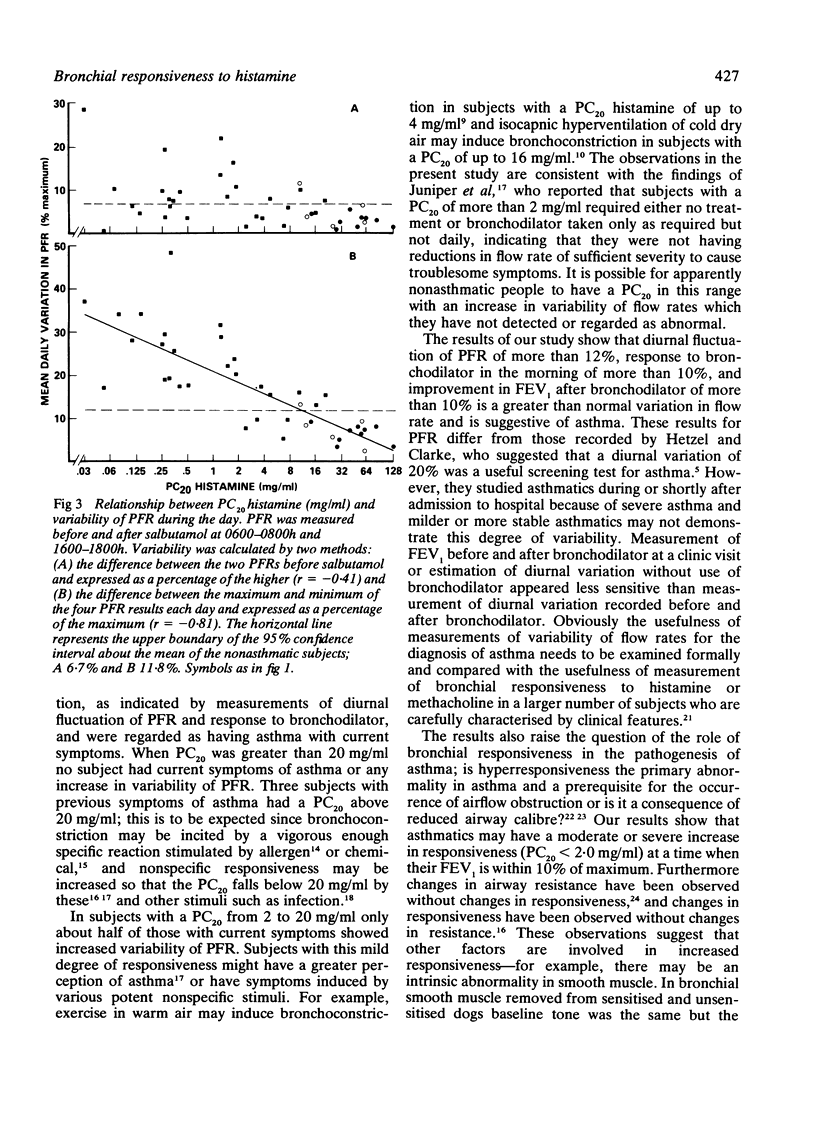
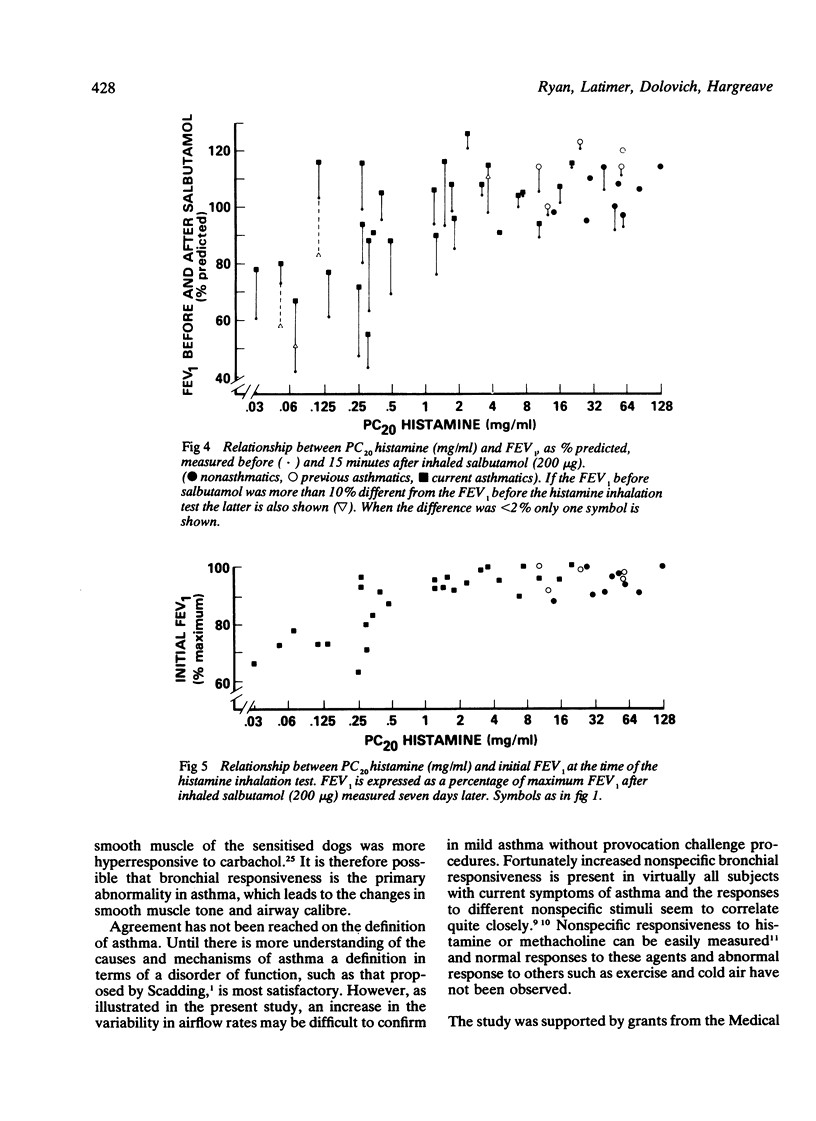
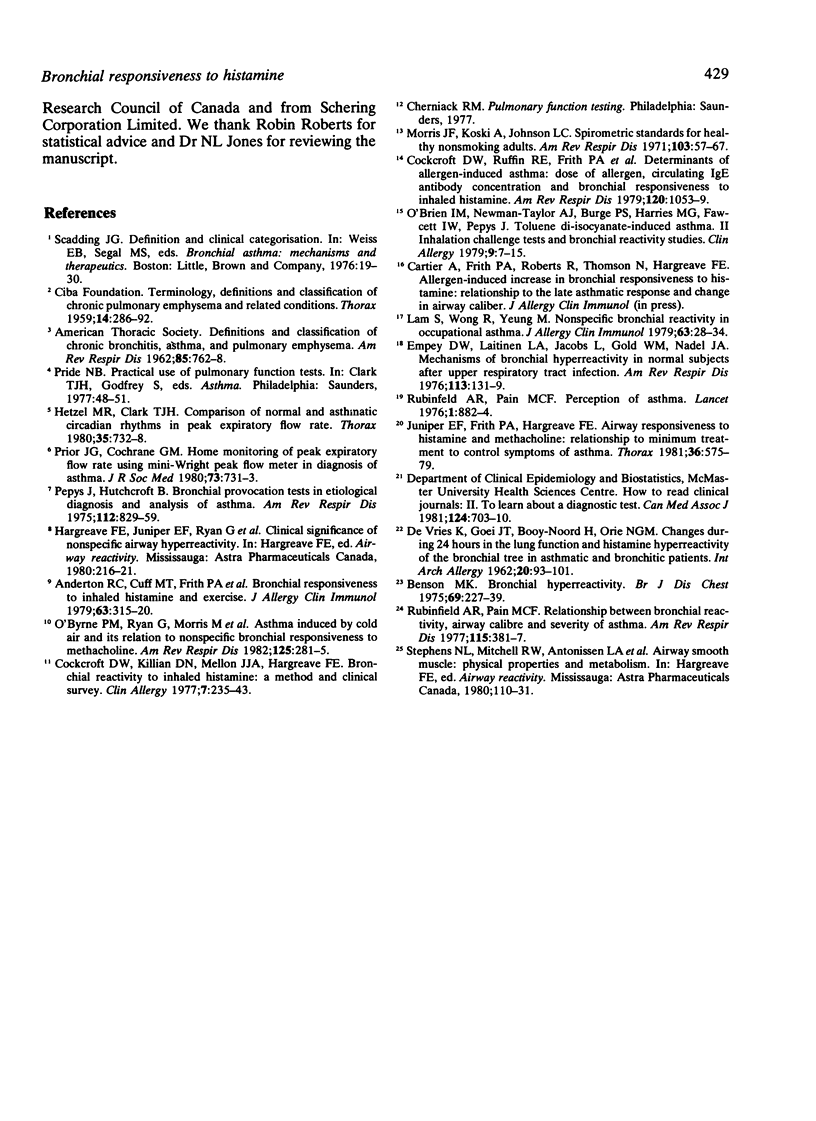
Selected References
These references are in PubMed. This may not be the complete list of references from this article.
- Anderton R. C., Cuff M. T., Frith P. A., Cockcroft D. W., Morse J. L., Jones N. L., Hargreave F. E. Bronchial responsiveness to inhaled histamine and exercise. J Allergy Clin Immunol. 1979 May;63(5):315–320. doi: 10.1016/0091-6749(79)90125-8. [DOI] [PubMed] [Google Scholar]
- Benson M. K. Bronchial hyperreactivity. Br J Dis Chest. 1975 Oct;69(0):227–239. doi: 10.1016/0007-0971(75)90090-x. [DOI] [PubMed] [Google Scholar]
- Cockcroft D. W., Killian D. N., Mellon J. J., Hargreave F. E. Bronchial reactivity to inhaled histamine: a method and clinical survey. Clin Allergy. 1977 May;7(3):235–243. doi: 10.1111/j.1365-2222.1977.tb01448.x. [DOI] [PubMed] [Google Scholar]
- Cockcroft D. W., Ruffin R. E., Frith P. A., Cartier A., Juniper E. F., Dolovich J., Hargreave F. E. Determinants of allergen-induced asthma: dose of allergen, circulating IgE antibody concentration, and bronchial responsiveness to inhaled histamine. Am Rev Respir Dis. 1979 Nov;120(5):1053–1058. doi: 10.1164/arrd.1979.120.5.1053. [DOI] [PubMed] [Google Scholar]
- Empey D. W., Laitinen L. A., Jacobs L., Gold W. M., Nadel J. A. Mechanisms of bronchial hyperreactivity in normal subjects after upper respiratory tract infection. Am Rev Respir Dis. 1976 Feb;113(2):131–139. doi: 10.1164/arrd.1976.113.2.131. [DOI] [PubMed] [Google Scholar]
- Hetzel M. R., Clark T. J. Comparison of normal and asthmatic circadian rhythms in peak expiratory flow rate. Thorax. 1980 Oct;35(10):732–738. doi: 10.1136/thx.35.10.732. [DOI] [PMC free article] [PubMed] [Google Scholar]
- Juniper E. F., Frith P. A., Hargreave F. E. Airway responsiveness to histamine and methacholine: relationship to minimum treatment to control symptoms of asthma. Thorax. 1981 Aug;36(8):575–579. doi: 10.1136/thx.36.8.575. [DOI] [PMC free article] [PubMed] [Google Scholar]
- Lam S., Wong R., Yeung M. Nonspecific bronchial reactivity in occupational asthma. J Allergy Clin Immunol. 1979 Jan;63(1):28–34. doi: 10.1016/0091-6749(79)90158-1. [DOI] [PubMed] [Google Scholar]
- Morris J. F., Koski A., Johnson L. C. Spirometric standards for healthy nonsmoking adults. Am Rev Respir Dis. 1971 Jan;103(1):57–67. doi: 10.1164/arrd.1971.103.1.57. [DOI] [PubMed] [Google Scholar]
- O'Brien I. M., Newman-Taylor A. J., Burge P. S., Harries M. G., Fawcett I. W., Pepys J. Toluene di-isocyanate-induced asthma. II. Inhalation challenge tests and bronchial reactivity studies. Clin Allergy. 1979 Jan;9(1):7–15. doi: 10.1111/j.1365-2222.1979.tb01517.x. [DOI] [PubMed] [Google Scholar]
- O'Byrne P. M., Ryan G., Morris M., McCormack D., Jones N. L., Morse J. L., Hargreave F. E. Asthma induced by cold air and its relation to nonspecific bronchial responsiveness to methacholine. Am Rev Respir Dis. 1982 Mar;125(3):281–285. doi: 10.1164/arrd.1982.125.3.281. [DOI] [PubMed] [Google Scholar]
- Pepys J., Hutchcroft B. J. Bronchial provocation tests in etiologic diagnosis and analysis of asthma. Am Rev Respir Dis. 1975 Dec;112(6):829–859. doi: 10.1164/arrd.1975.112.6.829. [DOI] [PubMed] [Google Scholar]
- Prior J. G., Cochrane G. M. Home-monitoring of peak expiratory flow rate using mini-Wright peak flow meter in diagnosis of asthma. J R Soc Med. 1980 Oct;73(10):731–733. [PMC free article] [PubMed] [Google Scholar]
- Rubinfeld A. R., Pain M. C. Perception of asthma. Lancet. 1976 Apr 24;1(7965):882–884. doi: 10.1016/s0140-6736(76)92097-3. [DOI] [PubMed] [Google Scholar]
- Rubinfeld A. R., Pain M. C. Relationship between bronchial reactivity, airway caliber, and severity of asthma. Am Rev Respir Dis. 1977 Mar;115(3):381–387. doi: 10.1164/arrd.1977.115.3.381. [DOI] [PubMed] [Google Scholar]
- de VRIES, GOEI J. T., BOOY-NOORD H., ORIE N. G. Changes during 24 hours in the lung function and histamine hyperreactivity of the bronchial tree in asthmatic and bronchitic patients. Int Arch Allergy Appl Immunol. 1962;20:93–101. doi: 10.1159/000229248. [DOI] [PubMed] [Google Scholar]


